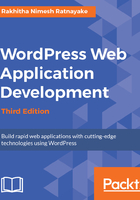
The MVC versus event-driven architecture
A vast majority of web development frameworks are built to work with MVC architecture, where an application is separated into independent layers called models, views, and controllers. In MVC, we have a clear understanding of what goes where and when each of the layers will be integrated in the process.
So, the first thing most developers will look at is the availability of MVC in WordPress. Unfortunately, WordPress is not built on top of the MVC architecture. This is one of the main reasons why developers refuse to choose it as a development framework. Even though it is not MVC, we can create custom execution processes to make it work like an MVC application. Also, we can find frameworks such as WP MVC, which can be used to take advantage of both WordPress's native functionality and its vast plugin library and all of the many advantages of an MVC framework. Unlike other frameworks, it won't have the full capabilities of MVC. However, the unavailability of MVC architecture doesn't mean that we cannot develop quality applications with WordPress. There are many other ways to separate concerns in WordPress applications.
On the other hand WordPress, relies on a procedural event-driven architecture with its action hooks and filters system. Once a user makes a request, these actions will get executed in a certain order to provide the response to the user. You can find the complete execution procedure at http://codex.wordpress.org/Plugin_API/Action_Reference.
In the event-driven architecture, both model and controller code gets scattered throughout the theme and plugin files. In the upcoming chapters, we will look at how we can separate these concerns with the event-driven architecture, in order to develop maintainable applications.